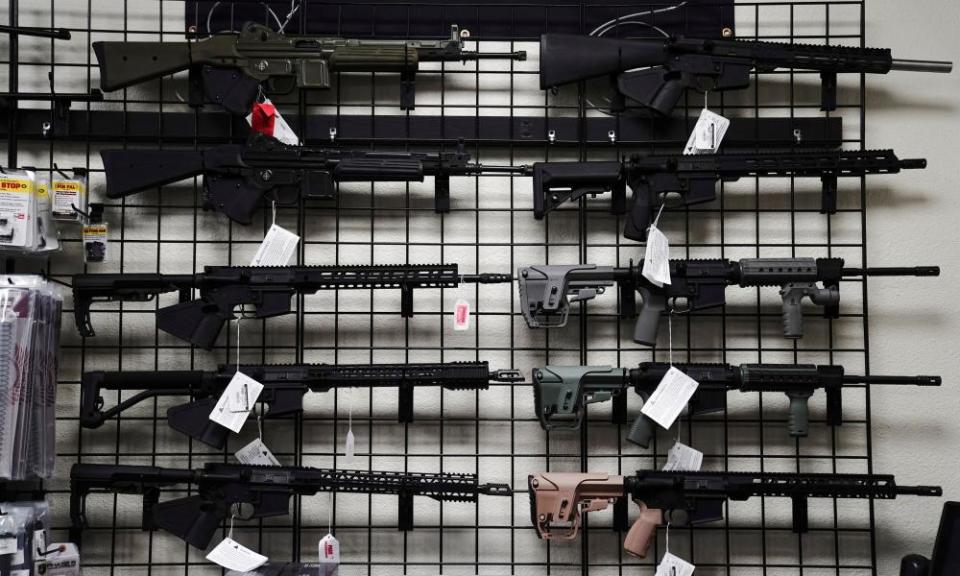Nashville shooting: what it reveals about Americans’ love of military-style guns

In September 2021, the gun manufacturer Smith & Wesson announced that it was relocating from the Massachusetts town in which it was incorporated in 1852 to a new location – Maryville in Blount county, Tennessee.
Related: Republican congressman says ‘we’re not going to fix’ school shootings
“We have been left with no other alternative,” the company complained, pointing to proposals in the Massachusetts legislature that would extend the state’s ban on AR-15 style rifles to the selling of all semi-automatic firearms. Some 750 jobs would be moved to Tennessee, the gun maker said, for a number of reasons, the first of which was that the state supported the second amendment right to bear arms.
Bill Lee, Tennessee’s Republican governor who has overseen the loosening of state gun laws in recent years including signing into law the ability of most adults to carry handguns without a permit, was ecstatic. “We’re proud this company has chosen to relocate to Blount Co,” he gloated.
Eighteen months later, and 180 miles away from Smith & Wesson’s sparkling new headquarters, a shooter entered a private Christian school in Nashville, Tennessee on Monday and gunned down three nine-year-old children and three adult staff. The killer was armed with two semi-automatic firearms – an AR-15 style rifle and a semi-automatic pistol, both of which would be banned under the Massachusetts bill.
The shooter also carried a third weapon, a handgun. Manufacturer: Smith & Wesson.
In the wake of the Nashville tragedy, social media platforms have lit up with chatter about the shooter identifying as a transgender man. But another, far more common and far more urgent, factor lies behind the carnage at the Covenant school: the sheer prevalence of assault firearms based on military designs that are marketed to American civilians by the gun industry.
The starkest illustration that America has a gun problem are the international comparisons. Figures compiled by the Small Arms Survey show that the country is awash with guns at vastly higher levels – both numerically and per capita – than any other country in the world.

In 2017 there were 393m legal and illicit firearms in the hands of US civilians. That quantity overshadows the next country in the league table: India, with 71m.
Expressed by civilian firearms for every 100 residents, the US still stands head and shoulders above the rest of the globe. It has 121 for each 100, compared with war-torn Yemen in second place with 53.
Drill down to the guns used in the Nashville shooting and the extent of the American gun nightmare is illustrated on a more granular level. The first of the shooter’s three guns was an AR-15 style assault rifle – a Lead Star Arms Grunt built by the Palmetto State Armory in South Carolina.
A Washington Post investigation published on Monday (coincidentally about four hours before the Nashville shooter entered the Covenant school) explores how the AR-15 – a weapon designed for the battlefield and admired by the Pentagon for its “phenomenal lethality” – has become the best-selling rifle in the US.
Polling data from the Washington Post and Ipsos suggests that about one in every 20 US adults – about 16m people – own at least one AR-15. The Post’s investigation also includes the devastating figure that AR-15s have been involved in 10 of the 17 deadliest mass shootings in the US in the past decade.
A report from Congress last July helps explain why gun manufacturers have turned so enthusiastically to flooding the US market with AR-15 style rifles. It found that gun makers generated more than $1bn in sales of the guns over the past decade.
The second weapon in the Nashville shooter’s possession suggests an even greater problem. That firearm appears to have been a semi-automatic pistol known as a KEL-TEC SUB2000.
Josh Sugarmann, executive director of the Violence Policy Center, said that the pistol pointed to an even more daunting threat than AR-15s: the ubiquity of civilian ownership of assault firearms of all sorts of different descriptions. “Many people, from the news media to policymakers, equate assault weapons with the AR-15 or the AK-47. The reality is that there are a wide range of assault guns that are being marketed to civilians – assault pistols, assault shotguns, 50-caliber anti-armor sniper rifles, and more.”
What these weapons have in common, Sugarmann said, was that they are anti-personnel firearms designed to kill the largest number of people in the shortest possible time. Their dominance in US gun sales has been achieved quite consciously, he said, by an industry that has become militarized.
“Across the board, every manufacturer has some type of assault weapon that they offer. What the industry has done is to embrace heightened lethality as the foundation of their marketing efforts, and we are seeing the end result of that in terms of deaths and injuries on a daily basis.”
Over the coming days more information will emerge about how the shooter came to buy seven firearms, including the three used in the rampage, entirely legally in recent days. Police have indicated this buying spree occurred even as the assailant was being treated for an emotional disorder.
None of that will touch on the even more disconcerting question: how weapons designed by the US military to kill large numbers of enemy combatants have become, in the words of one Republican lawmaker, the much-loved “national gun of America”.

 Yahoo News
Yahoo News 
